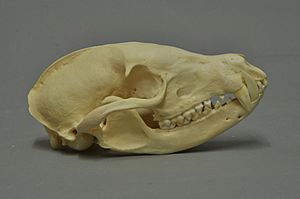White-nosed coati facts for kids
Quick facts for kids White-nosed coati |
|
|---|---|
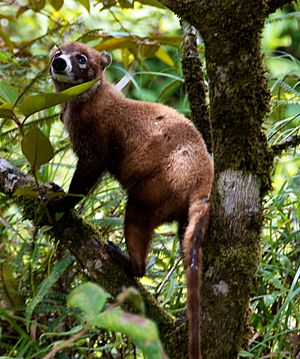 |
|
| in Costa Rica | |
| Conservation status | |
| Scientific classification | |
| Genus: |
Nasua
|
| Species: |
narica
|
| Subspecies | |
|
|
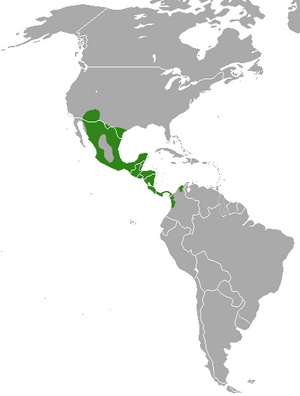 |
|
| The native range of the white-nosed coati. Note: Its Colombian range is restricted to the far northwest (see text). | |
| Synonyms | |
|
Viverra narica (Linnaeus, 1766) |
|
The white-nosed coati (Nasua narica), also called the coatimundi, is a type of coati. It belongs to the Procyonidae family, which includes raccoons and their relatives. People in different places call them by other names like pizote, antoon, or tejón.
These animals usually weigh about 4 to 6 kilograms (9 to 13 pounds). But there's a big difference between males and females! Small females can weigh as little as 2.5 kg (5.5 lb). Large males can be much heavier, up to 12.2 kg (27 lb). From their nose to the tip of their tail, coatis are about 110 centimeters (3.6 feet) long. Half of this length is just their tail!
Contents
Where Coatis Live: Habitat and Range
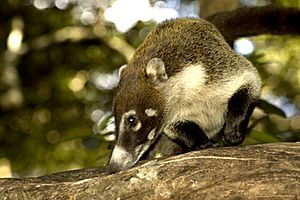
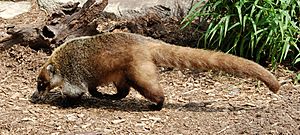
White-nosed coatis live in wooded areas across the Americas. You can find them in both dry and moist forests. They live from sea level up to 3,000 meters (9,800 feet) high.
Their home range stretches from southeastern Arizona and New Mexico in the north. It goes through Mexico and Central America. It reaches all the way to the far northwest of Colombia, near the border with Panama.
Coatis from Cozumel Island are a special kind. They are a bit smaller than coatis on the nearby mainland. Most experts now think they are a subspecies, which means they are a specific type of white-nosed coati.
You might also find white-nosed coatis in Florida, USA. They are not native there. This means they were brought to Florida by people. Some coatis escaped from captivity and started living in the wild. Now, there's a good chance they are living and having babies there.
What Coatis Eat: Feeding Habits
White-nosed coatis are omnivores. This means they eat both plants and animals. They like to eat small animals with backbones, fruits, and dead animals (carrion). They also enjoy insects, snakes, and eggs.
Coatis are good at climbing trees. They use their long tails to help them balance. But they usually look for food on the ground.
Animals that hunt coatis include boa snakes, large birds like raptors, cats, and tayras. Tayras are like large weasels. Coatis can get used to people easily. Like raccoons, they might look for food in campsites or trash cans. They are also quite smart and can be tamed.
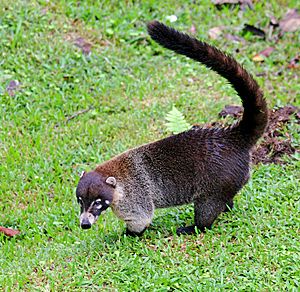
Coati Behavior and Social Life
Coatis are active during the day. This is called being diurnal. They sleep in a specific tree at night. Then they come down at sunrise to find food. But if people hunt them or they get food from human areas, they might become more active at night. This is called being nocturnal.
Adult male coatis live alone. But females and young males live in social groups. These groups use many sounds to talk to each other. They also spend time cleaning themselves and each other. They use their teeth and claws for grooming.
When the group goes looking for food, some adults stay behind. They act as babysitters for the young coati cubs. This is similar to how meerkats care for their young. Young males and even some females like to play-fight. Coatis might also have short fights over food.
White-nosed coatis help balsa trees grow. They visit the flowers of balsa trees and drink their nectar. When they do this, pollen from the flowers sticks to their faces. Later, this pollen falls off in the forest, helping the tree spread its seeds. The balsa tree gives coatis food and water when other resources are low. In return, the coati helps the tree reproduce.
See also
 In Spanish: Coatí de nariz blanca para niños
In Spanish: Coatí de nariz blanca para niños



